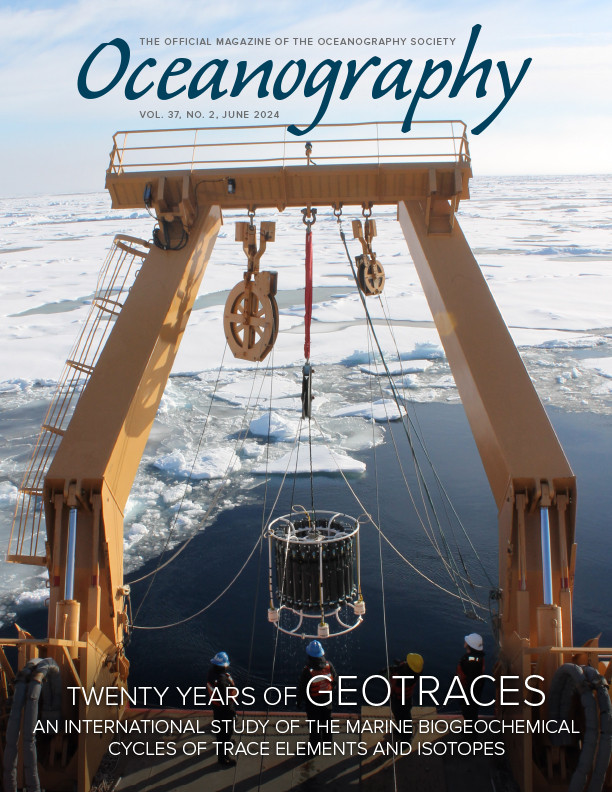Full Text
Introduction
This special issue of Oceanography celebrates the transformational findings of the international GEOTRACES program in chemical oceanography, 20 years after drafting of the GEOTRACES Science Plan in 2004 (GEOTRACES Planning Group, 2006). With the section cruise phase of the program ending soon, and a planned pivot toward smaller-scale process studies, this is an opportune time to look back at the achievements of GEOTRACES during the last two decades and to highlight some of the advances in our understanding of the processes that determine the oceanic distributions of trace elements and isotopes (TEIs).
GEOTRACES
GEOTRACES is a cooperative international effort comprising scientists from 35 countries, supported by national funding agencies, and guided by international steering committees. Since 2008, the program has carried out oceanographic, World Ocean Circulation Experiment (WOCE)-style “section” cruises throughout all the ocean basins. Rigorous intercalibration efforts stand at the foundation of GEOTRACES to ensure that basin-scale analyses made by individual nations can be compared without question. This has been achieved primarily by occupation of “crossover” stations between cruises hosted by different countries—perhaps the most evocative was a meeting of German and US GEOTRACES Arctic cruises at the North Pole in 2015. Moreover, the drive for publicly available synthesized datasets has resulted in the production of an online electronic atlas (https://www.egeotraces.org/) and the release of three intermediate data products to date, with a fourth expected in 2025. These efforts have led to a sea change in the quantity of high-quality TEI data available for the ocean, coupled with many advances in our understanding of the biogeochemical processes that determine these distributions (Anderson et al., 2014).
Articles in the Special Issue
This special issue begins with reflections from junior and senior scientists on the GEOTRACES program, the benefit of a multi-tracer approach for answering biogeochemical questions, and what life is like aboard a GEOTRACES section cruise (Anderson, Halbeisen, and Jeandel). A key success of GEOTRACES lies in the rigorous intercalibration of all data incorporated into its products, a process overseen by the Standards and Intercalibration Committee. This achievement is based on crucial cooperation among scientists who openly shared protocols, as discussed in Aguilar-Islas et al., and allows for both a holistic view of TEI cycling within a basin (e.g., Arctic Ocean; Jensen and Colombo) and synthesized intermediate data products that are valuable for research, education, and outreach efforts (as outlined by Schlitzer and Mieruch-Schnülle). In addition, from an education and outreach perspective, the GEOTRACES program office has produced a series of short educational videos, which are highlighted by Masferrer Dodas et al.
Several articles in this issue focus on “key parameters,” tracers that are deemed essential to the GEOTRACES program. For example, Anderson and Conway et al. both focus on dissolved iron and how GEOTRACES has elegantly demonstrated the utility of a multi-tracer approach and the unexpected and persistent nature of iron from deep boundary sources such as marine sediments and hydrothermal venting. Fitzsimmons and Steffen take a deeper dive into how GEOTRACES research on hydrothermal plumes have transformed our understanding of which TEIs are supplied or consumed by hydrothermal systems before influencing the wider ocean. Hayes provides an overview of the unique value of the thorium radionuclides as timekeepers for rates in the ocean and how they aid understanding of manifold biogeochemical processes, while Casciotti et al. describe recent advances in our understanding of the marine nitrogen cycle that have come from GEOTRACES and other efforts. Rafter then looks at how linking together elements such as iron and nitrogen can enhance insights into oceanic nutrient cycling.
The proliferation of GEOTRACES datasets has sparked renewed appreciation for the role of physical circulation in influencing global TEI distributions. The paper by de Souza and Morrison takes a close look at our increasing understanding of the role of the Southern Ocean “hub” in driving global nutrient and TEI distributions. However, it is not just knowledge of oceanic “dissolved” TEIs and circulation that are needed to understand marine biogeochemical cycles; GEOTRACES has also provided numerous advances in our knowledge of elemental speciation and organic complexation, marine particles, and aerosols as featured by several articles in this issue (Whitby et al., Twining, and Buck et al., respectively). Tagliabue and Weber provide an overview of how a range of different ocean biogeochemical modeling approaches have been stimulated by—and become invaluable in the interpretation of—GEOTRACES datasets. Lastly, we look to the future with Saito et al. describing the nascent BioGeoSCAPES program, which aims to build on advances from programs such as GEOTRACES and stimulate a research program designed to enhance understanding of the linkages between microbes, climate change, and biogeochemical cycles. We eagerly anticipate the development of this new program and the continuing discoveries to come from GEOTRACES.

